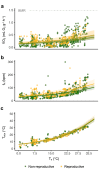Flexible energy-saving strategies in female temperate-zone bats
- PMID: 35939092
- PMCID: PMC9550788
- DOI: 10.1007/s00360-022-01452-7
Flexible energy-saving strategies in female temperate-zone bats
Abstract
Torpor is characterized by an extreme reduction in metabolism and a common energy-saving strategy of heterothermic animals. Torpor is often associated with cold temperatures, but in the last decades, more diverse and flexible forms of torpor have been described. For example, tropical bat species maintain a low metabolism and heart rate at high ambient and body temperatures. We investigated whether bats (Nyctalus noctula) from the cooler temperate European regions also show this form of torpor with metabolic inhibition at high body temperatures, and whether this would be as pronounced in reproductive as in non-reproductive bats. We simultaneously measured metabolic rate, heart rate, and skin temperature in non-reproductive and pregnant females at a range of ambient temperatures. We found that they can decouple metabolic rate and heart rate from body temperature: they maintained an extremely low metabolism and heart rate when exposed to ambient temperatures changing from 0 to 32.5 °C, irrespective of reproductive status. When we simulated natural temperature conditions, all non-reproductive bats used torpor throughout the experiment. Pregnant bats used variable strategies from torpor, to maintaining normothermy, or a combination of both. Even a short torpor bout during the day saved up to 33% of the bats' total energy expenditure. Especially at higher temperatures, heart rate was a much better predictor of metabolic rate than skin temperature. We suggest that the capability to flexibly save energy across a range of ambient temperatures within and between reproductive states may be an important ability of these bats and possibly other temperate-zone heterotherms.
Keywords: Heart rate; Metabolism; Nyctalus noctula; Reproduction; Thermoregulation; Torpor.
© 2022. The Author(s).
Conflict of interest statement
The authors have no relevant financial or non-financial interests to disclose.
Figures



Similar articles
-
High latitude northern bats (Eptesicus nilssonii) reveal adaptations to both high and low ambient temperatures.J Exp Biol. 2023 Nov 1;226(21):jeb245260. doi: 10.1242/jeb.245260. Epub 2023 Nov 3. J Exp Biol. 2023. PMID: 37815465
-
Bats on a budget: torpor-assisted migration saves time and energy.PLoS One. 2014 Dec 31;9(12):e115724. doi: 10.1371/journal.pone.0115724. eCollection 2014. PLoS One. 2014. PMID: 25551615 Free PMC article.
-
Short and hyperthermic torpor responses in the Malagasy bat Macronycteris commersoni reveal a broader hypometabolic scope in heterotherms.J Comp Physiol B. 2018 Nov;188(6):1015-1027. doi: 10.1007/s00360-018-1171-4. Epub 2018 Aug 18. J Comp Physiol B. 2018. PMID: 30121696
-
Heterothermic Migration Strategies in Flying Vertebrates.Integr Comp Biol. 2023 Dec 12;63(5):1060-1074. doi: 10.1093/icb/icad053. Integr Comp Biol. 2023. PMID: 37279461 Review.
-
Reproduction of Rescued Vespertilionid Bats (Nyctalus noctula) in Captivity: Veterinary and Physiologic Aspects.Vet Clin North Am Exot Anim Pract. 2017 May;20(2):665-677. doi: 10.1016/j.cvex.2016.11.013. Epub 2017 Feb 4. Vet Clin North Am Exot Anim Pract. 2017. PMID: 28169186 Review.
Cited by
-
In-situ responses of temperate-zone bats to climate change.Ann N Y Acad Sci. 2025 Apr;1546(1):23-34. doi: 10.1111/nyas.15317. Epub 2025 Mar 20. Ann N Y Acad Sci. 2025. PMID: 40112255 Free PMC article. Review.
-
Contrasting Torpor Use by Reproductive Male Common Noctule Bats in the Laboratory and in the Field.Integr Comp Biol. 2023 Dec 12;63(5):1087-1098. doi: 10.1093/icb/icad040. Integr Comp Biol. 2023. PMID: 37237444 Free PMC article.
-
Intraspecific variation in metabolic responses to diverse environmental conditions in the Malagasy bat Triaenops menamena.J Comp Physiol B. 2025 Apr;195(2):247-262. doi: 10.1007/s00360-025-01608-1. Epub 2025 Mar 20. J Comp Physiol B. 2025. PMID: 40111435 Free PMC article.
-
Heart rate monitoring reveals differential seasonal energetic trade-offs in male noctule bats.Proc Biol Sci. 2024 Jul;291(2026):20240855. doi: 10.1098/rspb.2024.0855. Epub 2024 Jul 10. Proc Biol Sci. 2024. PMID: 38981523 Free PMC article.
References
-
- Adams RA. Bat reproduction declines when conditions mimic climate change projections for western North America. Ecology. 2010;91:2437–2445. - PubMed
-
- Audet D, Fenton MB. Heterothermy and the use of torpor by the bat Eptesicus fuscus (Chiroptera: Vespertilionidae): a field study. Physiol Zool. 1988;61:197–204.
-
- Barclay MRR, Kalcounis MC, Crampton LH, Stefan C, Vonhof MJ, Wilkinson L, Brigham RM. Can external radiotransmitters be used to assess body temperature and torpor in bats? J Mammal. 1996;77:1102–1106.
-
- Bartoń,K (2020) MuMIn: multi-Model Inference. R package version 1.43.17
Publication types
MeSH terms
LinkOut - more resources
Full Text Sources

